
[Image above] Credit: McGill University; YouTube
Sometimes, inspiration can come from unexpected—and downright weird—places.
Like from this guy.

Credit: Lynn Chan; Flickr CC BY 2.0
That prehistoric-looking aquatic creature is an alligator gar, the largest of the gar species of ancient megafish. Alligator gar are intimidating—they can grow up to 10 feet long and weigh up to 300 lbs, with rows of sharp teeth and a heavily armored body. But despite their intimidating attributes, that latter characteristic of alligator gar supplies major materials inspiration.
That’s because gar scales are tough—really tough.
Wikipedia notes that gar scales are so tough that early cultures have used the scales as various tools. “The hard skin and scales of the gar were used by humans. Native Americans used the scales of the gar as arrowheads, native Caribbeans used the skin for breastplates, and early American pioneers covered the blades of their plows in gar skin.”
Part of that toughness comes from the materials that make up the scales, which include a layer of dentine (the mineralized material is also found inside human teeth) and a layer of inorganic bone salt. But it’s also the design and configuration of these scales that provide the gar with armor protection.

Credit: muzina_shanghai; Flickr CC BY-NC-ND 2.0
So it’s perhaps no surprise that gar scales have some interesting engineering principles to teach us about being both flexible and tough.
[We’ve written about how fish scales inspire materials research before—see this story from five years ago about the armor-scaled arapaima.]
By studying how fish scales deform, interact, and fracture, scientists at McGill University have uncovered mechanisms to translate that flexible strength into principles to engineer puncture-resistant gloves that can maintain dexterity while protecting workers with superior appendage protection.
Hand injuries are really common in industrial workplaces—according to U.S. Bureau of Labor Statistics figures, more than one million workers go to the emergency room every year due to hand injuries. And while 70% of those workers weren’t wearing gloves, 30% of those workers were wearing gloves—they just provided inadequate protection.
Part of the problem is that manufacturing flexible yet tough protective equipment isn’t as easy as it sounds, because these properties usually come at the expense of one another.
But as alligator gar prove, it doesn’t have to be that way.
Using fish scales as inspiration, a team from McGill University in Canada developed a flexible armor made of overlapping ceramic tiles. According to the school’s press release, “By using computer modeling, they were able to determine the optimal size, shape, arrangement, and overlap to make protective gloves that are much more resistant to piercing than those currently in use.”
While you may be tempted to think bigger is better when it comes to armor plates, the team’s puncture tests show that small, 0.6-mm-thick, high-purity alumina plates affixed to a flexible substrate were up to three times more puncture-resistant than longer ribbons of alumina.
That’s because the smaller sized tiles have lower flexural stress, which delays fracture of the tiles.
Plus, larger scales “produce stiffer responses, since large scales deform a larger volume of the backing material,” the authors write in the paper.

Credit: McGill University; YouTube
And while large scales always failed due to fracture, small scales had higher puncture resistance, although they required greater overlap of the tiles because they tended to tilt.
But, once again, there’s a trade-off between flexibility and toughness—while greater tile overlap increased puncture resistance, it also decreased flexibility. Overall, the authors conclude, small scales with reasonable overlap can offer the best protection for workers’ fingers.
“Fish scales surprised us,” postdoc and lead author Roberto Martini says in the press release. “It may sound counter intuitive, but we discovered that smaller scales are actually more difficult to pierce than the larger ones, something we can now fully explain using engineering analysis. We also learned that they are the toughest collagen-based material known.”
And, when it comes to fabricating protective gloves, other materials could be used as well. The authors suggest that alumina tiles affixed to carbon fiber mats could offer superior penetration resistance to morphing structures, while glass tiles affixed to cotton substrates could offer the possibility of transparent protection.
Hear and see more from the researchers themselves in the short video below.
The paper, published in Bioinspiration & Biomimetics, is “Stretch-and-release fabrication, testing and optimization of a flexible ceramic armor inspired from fish scales” (DOI: 10.1088/1748-3190/11/6/066001).

Credit: McGill University; YouTube
Author
April Gocha
CTT Categories
- Biomaterials & Medical
- Manufacturing
- Material Innovations
- Modeling & Simulation
Spotlight Categories
- Member Highlights


